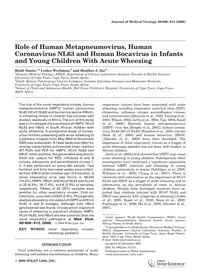
2008 Role of human metapneumovirus, human coronavirus NL63 and human bocavirus in infants and young children with acute PDF
Preview 2008 Role of human metapneumovirus, human coronavirus NL63 and human bocavirus in infants and young children with acute
Journal of Medical Virology 80:906–912 (2008) Role of Human Metapneumovirus, Human Coronavirus NL63 and Human Bocavirus in Infants and Young Children With Acute Wheezing Heidi Smuts,1* Lesley Workman,2 and Heather J. Zar3 1Division Medical Virology/NHLS, Department of Clinical Laboratory Sciences, Faculty of Health Sciences, University of Cape Town, Cape Town, South Africa 2South African Tuberculosis Vaccine Initiative, Institute Infectious Diseases and Molecular Medicine, University of Cape Town, Cape Town, South Africa 3School of Child and Adolescent Health, Red Cross Children’s Hospital, University of Cape Town, Cape Town, South Africa The role of the novel respiratory viruses, human metapneumovirus (hMPV), human coronavirus NL63 (HCoV NL63) and human bocavirus (HBoV), in wheezing illness in children has not been well studied, especially in Africa. The aim of this study was to investigate the prevalence of hMPV, HCoV NL63 and HBoV in South African children with acute wheezing. A prospective study of consec- utive children presenting with acute wheezing to a pediatric hospital from May 2004 to November 2005 was undertaken. A nasal swab was taken for reverse transcription-polymerase chain reaction (RT-PCR) and PCR for hMPV, HCoV NL63 and HBoV; when positive, the genes were sequenced. Shell vial culture for RSV, influenza A and B viruses, adenovirus and parainfluenza viruses 1, 2, 3 was performed on every 5th sample. Two hundred and forty two nasal swabs were collect- ed from 238 children (median age 12.4 months). A novel respiratory virus was found in 44/242 (18.2%). hMPV, HBoV, and HCoV NL63 was found in 20 (8.3%), 18 (7.4%), and 6 (2.4%) of samples, respectively. Fifteen of 59 (25%) samples were positive for other respiratory viruses. Viral co- infections, occurred in 6/242 (2.5%). Phylogenetic analysisshowedco-circulationofhMPVandHCoV NL63 A and B lineages, although only HBoV genotype st2 was found. Viruses are an important cause of wheezing in preschool children; hMPV, HCoV NL63, and HBoV are less common than the usual respiratory pathogens. J. Med. Virol. 80:906–912, 2008. � 2008 Wiley-Liss, Inc. KEY WORDS: novel respiratory viruses; wheezing; pediatric INTRODUCTION Viral infections are a common precipitant of acute wheezing and asthma exacerbations in children. Many respiratory viruses have been associated with acute wheezing, including respiratory syncytial virus (RSV), rhinovirus, influenza viruses, parainfluenza viruses, and enteroviruses [Johnston et al., 1995; Taussig et al., 2003; Wilson, 2003; Jartti et al., 2004; Tan, 2004; Kusel et al., 2006]. Recently human metapneumovirus (hMPV) [van den Hoogen et al., 2001], human corona- virus NL63 (HCoV NL63) [Fouchier et al., 2004; van der Hoek et al., 2004] and human bocavirus (HBoV) [Allander et al., 2005] have been described. The importance of these respiratory viruses as a trigger of acute wheezing episodes has not been well studied in African children. Jartti et al. [2002] first showed that hMPV may cause acute wheezing in young children. Subsequently other investigators have confirmed a significant association between hMPV infection and wheezing in young children, particularly in winter [Schildgen et al., 2005; Williams et al., 2005; Chung et al., 2007]. There is relatively little information on the importance of HCoV NL63 and HBoV as a trigger of acute wheezing and no information on the prevalence of these in African children. Studies from developed countries have re- ported that children infected with HCoV NL63 and HBoV may present with symptoms of wheezing [Arden et al., 2005; Esper et al., 2005; Moes et al., 2005; Foulongne et al., 2006; Ma et al., 2006; Allander et al., 2007]. Grant sponsor: World Health Organization (WHO); Grant sponsor: Glaxosmithkline Research Award; Grant sponsor: Allergy Society of South Africa. *Correspondence to: Heidi Smuts, Division of Medical Virology/ NHLS, Department Clinical Laboratory Sciences, Faculty of Health Sciences, University of Cape Town, Anzio Road, Observ- atory 7925, Cape Town, South Africa. E-mail:
